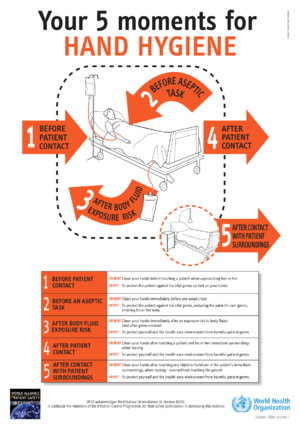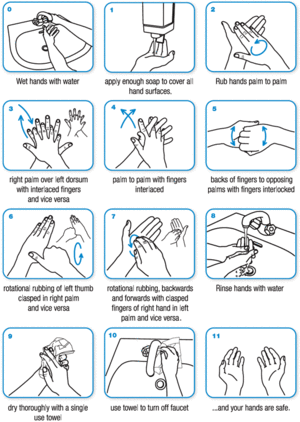Hand hygiene protocol
Jump to navigation
Jump to search
This page describes protocol, or, how to do things with QueerCare. You should check how to read protocol well if you're new to QueerCare.
Hand hygiene refers to the process of making sure that your hands are not transmitting infection from one person to another, or from one person to vulnerable areas of yourself (your eyes, mouth, nose and broadly your face).
When to do hand hygiene
You should do hand hygiene as often as possible, but while doing care work you must do it:
- Before touching your face
- to prevent infection spreading from your surroundings onto your face.
- After touching your face
- to prevent infection spreading from your potentially infected face to your surroundings.
- Before touching something that is disinfected
- to prevent spreading infection to something that is disinfected.
- Before being in close contact (within 2m) with someone you suspect, or know, has COVID-19
- because maybe they don't have it, or you may have some other infection on your hands which could make their COVID much worse.
- After being in close contact (within 2m) with someone you suspect, or know, has COVID-19
- to prevent you taking the infection from them and spreading it to yourself or others.
- Before putting on PPE
- to prevent you getting any infection on your hands onto masks, gowns or other PPE which could spread it further.
- After removing PPE
- to prevent you spreading any infection on the PPE. Do hand hygiene after removing gloves and gowns, and again after removing masks
- Before aseptic tasks
- if you're reading this hopefully you're not doing aseptic tasks
- After contact, or potential contact with bodily fluids, even if you were wearing gloves
- this is to protect your surroundings from any bodily fluids that may have gotten through your PPE.
- Before touching anyone you're supporting.
- to protect the person you're supporting from infection on yourself and your surroundings .
- After touching anyone you're supporting.
- to protect yourself and your surroundings from infection on the person you're supporting.
- After touching anything in your surroundings
- to prevent yourself and people you're caring for from infection on your surroundings, and prevent you from carrying infection from one person to another.
How to do hand hygiene
Hand hygiene can be done in two ways: with hand sanitiser or with soap and water. The steps are the same whether you use hand sanitiser or water, except at the end. You can use bar soap or liquid soap with no difference in procedure. There is no need to use antibacterial soap to remove COVID-19: any soap is equally effective.
- If you are using soap and water, you must set the tap running and leave it running.
- Wet your hands and apply soap to them, until a foamy lather forms. If using alcohol hand sanitiser, apply enough to your hand to be able to coat all of your hands.
- Rub your hands palm to palm, covering your hands and insides of the fingers completely.
- Lay one hand on top of another, so that your palm rests on the back of your hand, and mesh your fingers together. Move your hands back and forwards to scrub them. Swap over after a couple of seconds, and scrub the other back of your hands.
- Lay your hands palm to palm, and mesh your fingers together, and scrub them together.
- With one hand facing up and the other hand facing down, hook your fingers together, and rub the backs of your fingers along your palms.
- Wrap one hand around the opposite thumb and twist several times, and repeat on the other thumb with the opposite hand.
- Lay the tips of one hand against the opposite palm, and scrub them in circles for a few seconds. Swap and do the opposite hand.
- Dry your hands:
- If you're using hand sanitiser you must hold your hands in the air until they are dry.
- If you're using soap and water you should use a disposable paper towel to dry your hands and then use that towel to turn the tap off.

